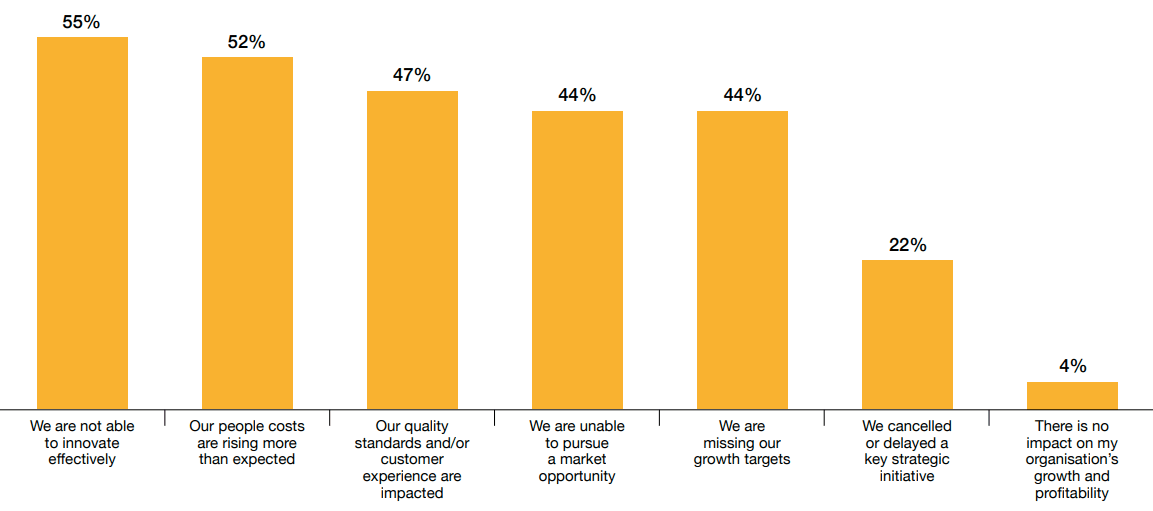Key Trends in Workforce Upskilling and Reskilling We See in Large Enterprises
Why 84% of Companies Fail to Reskill Their Workforce
To ensure continuous business growth, increase their competitive advantage, and, most importantly, have the ability to quickly adapt to the ever-changing work environment, companies keep searching for new opportunities. It’s not a secret that the bedrock of fast market adaptation is the right mix of technology and human capital.
However, in times of growing skills mismatch, talent shortages, and a wide range of tools to choose from, the question of ensuring business growth and agility becomes urgent. Today, we’ll get you through the top challenges of your business future-proofing and share with you a smart, budget-friendly way to deal with them.
Why companies fail to become future-ready
It all comes down to the lack of the right skills.
The 2019 report Towards a Reskilling Revolution: Industry-Led Action for the Future of Work by WEF revealed that 60% of U.S. companies believe that skill gaps prevent them from implementing the right technology and, consequently, from effectively adapting to the volatile business environment.

As we can see from the findings, skill and knowledge gaps don’t allow companies to capitalize on the opportunities that technologies provide. Moreover, hiring the distributed workforce to bridge the talent gap is not an ultimate solution anymore since skill gaps are seen across the global labor market.
PwC’s 2019 Annual Global CEO Survey identified six areas that get affected by the lack of skills and, as a consequence, impact overall business performance.

With such results, four out of five CEOs see the lack of skills as a top threat to business growth. That’s why, according to the McKinsey survey, 66% of executives see upskilling and reskilling of their workforce as one of the top ten priorities with 62% believing that they will need to reskill more than 25% of the workforce between now and 2023. A whopping majority of companies (64%) are ready to step up investments in training seeking to improve workforce productivity.
However, as McKinsey found out, only 16% of companies feel prepared to initiate upskilling their workforce to address critical skill gaps. What’s the reason?
Whether companies need to completely develop new competencies or just add some skill sets to help their workforce transition to new roles and responsibilities, they face two key challenges.
- The lack of money
The report by WEF also revealed that reskilling of 1.37 million workers who will be displaced out of their roles within the next ten years will cost companies $34 billion. It means that, on average, they will spend $24,800 per worker on reskilling. At the same time, with an overall investment of $4.7 billion, companies could reskill 25% of the workforce with a positive cost-benefit balance. Though it’s a huge investment, it’s still more financially beneficial than firing and hiring.
- The lack of know-how
Companies simply don’t know how to approach the reskilling question. As McKinsey pointed out, the majority of executives have little understanding of “what it will take to meet the reskilling challenge at the kind of scale the next decade will likely demand.” Their main issue is to understand how to check their current in-house talent against future changing responsibilities and processes to reskill their workforce the right way.
So how to go about it?
How to address the main challenges for reskilling in the gig economy
In the near future, your workforce is highly likely to work on short-term specific projects like freelancers do today rather than stick to one and maintain the same responsibilities. It means that ongoing reskilling will be a natural response to the gig-like work environment.
For this reason, some companies have already mapped out their reskilling strategy.
Problem: Lack of talent.
Solution: Define critical areas where the talent is needed and create reskilling programs with the right incentive programs.
Lacking the right talent to fill critical roles, Amazon is offering its warehouse workers a 16-week certification program intended to transfer them to data centers. Experiencing a growing need for data technicians, Amazon doesn’t waste time on looking for ready-made specialists. Instead, the company is ready to double its warehouse workforce earnings if they develop critical skills.
Problem: Lack of specific skills.
Solution: Focus on the required skills rather than job roles. Through available data, map the existing workforce skills and drive reskilling for mission-critical skill sets through personalized learning.
AT&T introduced the WF2020 program to close the talent gap by reskilling their workforce. The goal was to identify the required skills and create roadmaps to acquire them. Next, 250 job roles were simplified and consolidated into 80 to increase job mobility within a company and develop interdisciplinary skills. Also, this program was focused more on measuring how each individual contributed to business objectives, thereby improving performance management.
However, these cases obviously won’t work for every company. The fast-paced environment, limited budgets and uncertainty about the required future skills can create additional challenges. However, it doesn’t mean that you can’t develop a smart performance management strategy.
Your strategic reskilling should start with ongoing, personalized talent development that is focused on each individual’s performance. For this, you will need data and technology that would work together to accurately track the progress of your workforce to offer relevant learning and business activities crucial for your evolving business and industry. You don’t need to rush to obtain future skill sets if you’re continuously assessing and developing them step-by-step now, ingraining knowledge into practice right away.
Upon making an investment in the right performance management tools, you will not only improve your current workforce productivity by upskilling them but will also gain long-term benefits in the form of an in-house talent pool and a hefty ROI.
To see how Rallyware drives distributed workforce productivity, request a demo.
News and Insights on Workforce Training & Engagement
We’re among top-notch eLearning and business engagement platforms recognized for effective training and talent development, helping to empower distributed workforces
Subscribe
